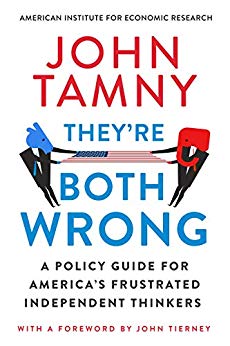The Impossibility of Negative Rates

The economics discussion would be greatly enhanced if it were better understood that underlying all spending, selling, saving, lending, borrowing, and investing is an exchange of products, services or labor. Real things are always and everywhere being moved around when “money” changes hands.
It cannot be stressed enough that “money” is just an agreement about value that only has use insofar as there’s already wealth. Money does not instigate despite what economists, pundits and politicians tell you, rather it’s a consequence. We produce goods, we save them, we direct them to higher uses in the near-term since our needs are long-term (investment), and money is merely the medium that facilitates the movement of real things.
This requires mention ahead of what AEI resident scholar Paul Kupiec wrote in a recent Wall Street Journal opinion piece. Writing about the alleged tax implications of the impossibility that is “negative interest rates,” Kupiec observed that “the Fed hopes to avoid resorting to negative interest rates during the next recession, [but] without them the central bank’s ability to stimulate growth may be limited.” No, that’s not correct.
Readers should never forget that no one borrows dollars. Never. They borrow what dollars can be exchanged for: once again products, services, and most crucial of all to productive economic activity, labor. It’s all a reminder that the Fed’s ability to stimulate or shrink through its rate mechanism is only real in the eyes of economists, the media members who enable them, along with politicians who simply don’t know any better.
In the real economy, we borrow real things when we seek dollars, which means that the notion of Fed “ease” is pure fantasy. For one, dollars are the measure used to facilitate lending globally. Assuming a slowdown in U.S. economic activity, or a retrenchment by U.S. economic actors, the globalized nature of dollar credit means that increasingly austere market providers of dollars will overwhelm any artificial attempts by the Fed to rewrite reality with so-called “easy money.” In other words, what the Fed falsely “gives,” market sources of credit will take away.
After which we must return to the simple truth that the Fed can in no way increase access to the products, services and labor that borrowers seek when they borrow dollars. Implicit in Kupiec’s analysis is that the Fed can decree easy access to economic resources by merely fiddling with a rate. No, it can do no such thing.
And since some will ask, it’s worth briefly stressing that the Fed can’t alter the truth about price controls either. Assuming the Fed could decree zero or negative rates that market actors would actually abide (they wouldn’t, but let’s briefly imagine that they might), such a scenario would logically result in credit scarcity. Get it? When cities decree artificially low apartment rents, access to the latter shrinks as opposed to increasing. To believe the Fed can create abundance of credit through imposition of artificially low rates is much less than serious.
Which brings us to Kupiec’s mere suggestion that the Fed could engineer negative rates in a recession, and that doing so would prove stimulative. No, that’s an impossibility.
To see why, consider what investors do when they buy bonds. They in simple form buy bonds for say $100,000 now with an eye on getting the $100,000 back in the future, plus interest (let’s say for fun, 3%) throughout the life of the debt instrument. In short, they’re buying income streams meant to produce more than $100,000 for them over yet again the life of the bond. But that’s not what they’re really doing. With investment it’s always an exchange of resources with a view to attaining more resources in the future.
To buy a bond is to shift resource access to the borrower (think yet again products, services, and labor) in the present in order to attain access to products, services and labor in greater amounts in the future. Products for products. Always.
Yet explicit in negative rates is that investors, corporations and other holders of dollar wealth would quite literally provide resource access to borrowers in the near term worth – say – $100,000 in order to receive less than $100,000 worth of resources down the line. It’s all a reminder that in the real economy, negative rates are an impossibility. Once again, no one buys bonds, or the income streams that bonds pay out, as much as they buy the right to access greater amounts of goods (the income streams exchangeable for goods and services) in the future. Explicit in negative rates is that investors and businesses would literally invest in order to shrink the exchangeable value of their investment in the future. No chance.
In Kupiec’s defense, he acknowledges the above truth, though somewhat vaguely. He notes that when “corporate treasurers first faced negative deposit rates in Switzerland and Denmark, they looked for new places to park their cash balances.” Well, of course they did. Imagine what the stock market would look like if businesses were knowingly putting their dollar, euro, yen, Pound (name the currency) profits to work with an eye on shrinking their value. Or imagine if investors were pursuing negative returns.
Thankfully they don’t have to. Explicit in the market impossibility that is negative rates is that there’s a “glut” of savings such that economic resources are worse than useless. No. Not happening. Not during a recession, and not during a boom. Such a view is rather ignorant per Henry Hazlitt. So long as people have unmet wants, meaning forever, and so long as innovative thinkers have visions for improving, or better yet transforming our future, interest rates will always be positive to reflect the expense of accessing resources to bring the future into the present.
So what of negative rates? They do exist, don’t they? Yes, but what Kupiec left out is that the owners of these negative-yielding debt instruments aren’t investors, businesses or individuals; rather they’re central banks, insurance companies and pension funds. Oh well, central banks exist at the pleasure of governments, while insurance companies and pension funds operate with varying degrees of protection from government. And even the three entities mentioned have limits to how dense they can be. Ultimately insurance companies and pensions must produce returns, and central banks must remain somewhat solvent. In short, their capacity to absorb what is mindless has limits.
Looking ahead to the next downturn, economic laws will still exist. No doubt central banks cheered on by economists will promise all manner of interventions to allegedly soften the blow. And they’ll fail. Thankfully so. If central planners could truly alter reality for the better, as so many so sadly still believe, then the 20th century wouldn’t have been the murderous disaster that it was for so many. What’s too bad is that these lessons still haven’t sunk in with economists lucky enough to have prominent perches from which they’re empowered to preach what defies simple common sense.











